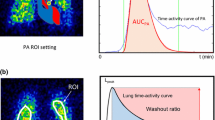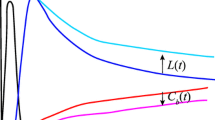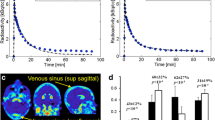Abstract
While N-isopropyl-p-[123I]iodoamphetamine (IMP) is commonly used as a flow tracer, significant clearance from the brain causes underestimation of CBF as compared with true CBF when conventional microsphere model analysis is applied. We previously reported a simple “table lookup” method for CBF measurement using IMP taking into account this clearance effect. The method is based on a two-compartment model, the K1 (corresponding to CBF) and k2 constants being obtained from a table from the ratio of the 1st SPECT (40 min) to the 2nd SPECT (180 min) counts. Arterial input data used were obtained by one point blood sampling 10 min after IMP infusion against the standard input function. In the present study, this approach was compared with conventional microsphere model analysis. For 30 subjects, the latter method entailed 8 min continuous arterial blood sampling after IMP infusion and the use of SPECT data at the end of this period, calibrated by a count ratio of 8 min/40 min planar images of whole brains. A good correlation was observed between the two methods (r = 0.88), but an overestimation of table look-up method CBF as compared with microsphere model CBF was observed contrary to theoretical predictions. Limitations in the estimation of SPECT data at 8 min, obtained with SPECT data at 40 min for calibration of the count ratio of 8 min/40 min whole brain planar images, might be responsible for this.
Similar content being viewed by others
References
Winchell HS, Baldwin RM, Lin TH. Development of I-123-labeled amines for brain studies: localization of I-123 iodophenylalkyl amines in rat brain.J Nucl Med 21: 940–946, 1980.
Winchell HS, Horst WD, Braun L, Oldendorf WH, Hattner R, Parker H. N-isopropyl-[123I]p-iodoamphetamine: single-pass brain uptake and washout; binding to brain synaptosomes; and localization in dog and monkey brain.J Nucl Med 21: 947–952, 1980.
Creutzig H, Schober O, Gielow P, Friedrich R, Becker H, Dietz H, et al. Cerebral dynamics of N-isopropyl-(123I)piodoamphetamine.J Nucl Med 27: 178–183, 1986.
Nishizawa S, Tanada S, Yonekura Y, Fujita T, Mukai T, Saji H, et al. Regional dynamics of N-isopropyl-(123I)piodoamphetamine in human brain.J Nucl Med 30: 150–156, 1989.
Kuhl DE, Barrio JR, Huang SC, Selin C, Ackermann RF, Lear JL, et al. Quantifying local cerebral blood flow by Nisopropyl-p-[123I]iodoamphetamine (IMP) tomography.J Nucl Med 23: 196–203, 1982.
Greenberg JH, Kushner M, Rango M, Alavi A, Reivich M. Validation studies of iodine-123-iodoamphetamine as a cerebral blood flow tracer using emission tomography.J Nucl Med 31: 1364–1369, 1990.
Murase K, Tanada S, Mogami H, Kawamura M, Miyagawa M, Yamada M, et al. Validation of microsphere model in cerebral blood flow measurement using N-isopropyl-p-(123I)iodoamphetamine.Med Phys 17: 79–83, 1990.
Yokoi T, Iida H, Itoh H, Kanno I. A new graphic plot analysis for cerebral blood flow and partition coefficient with iodine-123-iodoamphetamine and dynamic SPECT validation studies using oxygen-15-water and PET.J Nucl Med 34: 498–505, 1993.
Yonekura Y, Nishizawa S, Mukai T, Iwasaki Y, Fukuyama H, Ishikawa M, et al. Functional mapping of flow and back-diffusion rate of N-isopropyl-p-iodoamphetamine in human brain.J Nucl Med 34: 839–844, 1993.
Iida H, Itoh H, Bloomfield PM, Munaka M, Higano S, Murakami M, et al. A method to quantitate cerebral blood flow using a rotating gamma camera and iodine-123 iodoamphetamine with one blood sampling.Eur J Nucl Med 21: 1072–1084, 1994.
Iida H, Itoh H, Munaka M, Murakami M, Higano S, Uemura K. A clinical method to quantitate CBF using a rotating gamma camera and I-123-amphetamine (IMP) with one blood sampling.J Nucl Med 33: 963P, 1992.
Itoh H, Iida H, Murakami M, Bloomfield PM, Miura S, Okudera T, et al. A method for measurement of regional cerebral blood flow using N-isopropyl-p-[123I]iodoamphetamine (123I-IMP) SPECT; two scans with one point blood sampling technique.KAKU IGAKU (Jpn J Nucl Med) 29: 1193–1200, 1992.
Matsuda H, Seki H, Sumiya H, Tsuji S, Tonami N, Hisada K, et al. Quantitative cerebral blood flow measurements using N-isopropyl-(iodine 123)p-iodoamphetamine and single photon emission computed tomography with rotating gamma camera.Am J Physiol Imag 1: 186–194, 1986.
Kouris K, Jarritt PH, Costa DC, Ell PJ. Physical assessment of the GE/CGR Neurocam and comparison with a single rotating gamma-camera.Eur J Nucl Med 19: 236–242, 1992.
Itoh H, Iida H, Bloomfield PM, Murakami M, Higano S, Munaka M, et al. A technique for rapid imaging of regional CBF and partition coefficient using dynamic SPECT and I-123-amphetamine (IMP).J Nucl Med 33: P911, 1992.
Murase K, Tanada S, Inoue T, Ochi K, Fujita H, Sakaki S, et al. Measurement of the blood-brain barrier permeability of I-123 IMP, Tc-99m HMPAO and Tc-99m ECD in the human brain using compartment model analysis and dynamic SPECT.J Nucl Med 32: P911, 1991.
Huang SC, Mahoney DK, Phelps ME. Quantitation in positron emission tomography: 8. Effects of nonlinear parameter estimation on functional images.J Comput Assist Tomogr 11: 314–325, 1987.
Takahashi N, Ohkubo M, Odano I, Sakai K. A problem of quantitative measurement of regional cerebral blood flow using microsphere model and N-isopropyl-p-[123I]iodoamphetamine (IMP): Comparison with133Xe SPECT and sequential dynamic123I-IMP SPECT.KAKU IGAKU (Jpn J Nucl Med) 31: 319–326, 1994.
Iida H, Kanno I, Miura S, Murakami M, Takahashi K, Uemura K. Error analysis of a quantitative cerebral blood flow measurement using H2 15O autoradiography and positron emission tomography, with respect to the dispersion of the input function.J Cereb Blood Flow Metab 6: 536–545, 1986.
Iida H, Higano S, Tomura N, Shishido F, Kanno I, Miura S, et al. Evaluation of regional differences of tracer appearance time in cerebral tissues using [15O]water and dynamic positron emission tomography.J Cereb Blood Flow Metab 8: 285–288, 1988.
Iida H, Kanno I, Miura S, Murakami M, Takahashi K, Uemura K. A determination of the regional brain/blood partition coefficient of water using dynamic positron emission tomography.J Cereb Blood Flow Metab 9: 874–885, 1989.
Author information
Authors and Affiliations
Rights and permissions
About this article
Cite this article
Ito, H., Ishii, K., Atsumi, H. et al. Error analysis of table look-up method for cerebral blood flow measurement by123I-IMP brain SPECT: Comparison with conventional microsphere model method. Ann Nucl Med 9, 75–80 (1995). https://doi.org/10.1007/BF03164970
Received:
Accepted:
Issue Date:
DOI: https://doi.org/10.1007/BF03164970




